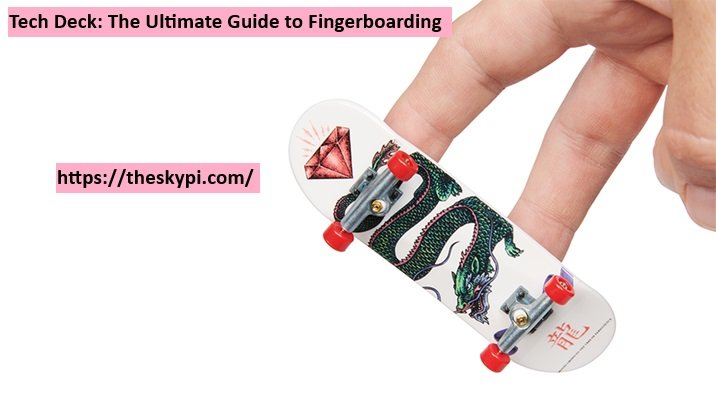Tech Deck has become a household name for anyone interested in fingerboarding, a sport that simulates skateboarding but on a miniature scale using fingers instead of feet. Since its inception, Tech Deck has not only introduced countless enthusiasts to the world of fingerboarding but has also established itself as the premier brand in this niche hobby. This guide explores everything you need to know about TechDeck.com from its history and influence on fingerboard culture to tips on mastering tricks and building your collection.
The Origins of Tech Deck
The Birth of a Phenomenon
Tech Deck was launched in the late 1990s, at a time when skateboarding was reaching new heights in popularity. The brand was created by a group of entrepreneurs who saw potential in the growing trend of fingerboarding, which involved using miniature skateboards that could be maneuvered with fingers to replicate skateboarding tricks. The idea was simple yet innovative—bringing the excitement of skateboarding to a smaller, more accessible format that could be enjoyed anytime, anywhere.
The original Tech Deck fingerboards were just 96mm in length and featured real metal trucks, grip tape, and interchangeable wheels, making them highly detailed replicas of full-sized skateboards. The attention to detail and quality craftsmanship quickly set Tech Deck apart from other toys and established it as the go-to brand for fingerboarding enthusiasts.
Partnership with Real Skate Brands
One of the key factors that contributed to Tech Deck’s success was its collaboration with real skateboarding brands. From the beginning, Tech Deck partnered with popular skateboard companies like Birdhouse, Toy Machine, and World Industries to create fingerboards featuring authentic graphics and designs. This collaboration allowed fans to collect miniature versions of their favorite pro skateboards, further blurring the lines between the toy and the real sport.
These partnerships also helped legitimize Tech Deck within the skateboarding community, as the fingerboards became a way for fans to engage with the sport even when they couldn’t be on a full-sized skateboard.
The Anatomy of a Tech Deck Fingerboard
Components and Features
A Tech Deck fingerboard is made up of several key components that mimic the construction of a full-sized skateboard. Understanding these components can help you appreciate the craftsmanship involved and improve your fingerboarding skills.
- Deck: The deck is the main part of the fingerboard, usually made from plastic or wood, and measures around 96mm in length. Just like real skateboards, Tech Decks come in various shapes and sizes, allowing for different styles of fingerboarding.
- Grip Tape: Grip tape is applied to the top of the deck to provide traction for your fingers, just as it does for your feet on a full-sized skateboard. This ensures better control and precision when performing tricks.
- Trucks: The trucks are metal components that attach to the bottom of the deck and hold the wheels in place. Tech Deck trucks are adjustable, allowing for customization of the fingerboard’s performance.
- Wheels: Tech Deck fingerboards feature real spinning wheels that allow for smooth movement. The wheels can be swapped out for different types to suit various fingerboarding surfaces and preferences.
- Graphics: One of the standout features of Tech Deck fingerboards is the detailed graphics on the deck, often replicating the designs of real pro skateboards. These graphics not only enhance the aesthetic appeal but also make the fingerboards collectible items.
Customization Options
One of the most exciting aspects of Tech Deck fingerboarding is the ability to customize your setup. Just like in skateboarding, customization allows you to tailor your fingerboard to your specific style and preferences. Tech Deck offers a wide range of components that can be mixed and matched, including different decks, trucks, wheels, and grip tape colors.
For those looking to take their customization to the next level, Tech Deck also offers DIY (Do-It-Yourself) kits that allow you to design and build your own fingerboard from scratch. These kits typically include blank decks, paint, stickers, and other accessories, giving you complete creative control over your fingerboard’s look and feel.
Mastering Fingerboard Tricks
Basic Tricks to Get Started
Fingerboarding, like skateboarding, involves a variety of tricks that range from simple to complex. Here are a few basic tricks to help you get started:
- Ollie: The ollie is the foundational trick in fingerboarding, just as it is in skateboarding. To perform an ollie, place your fingers on the grip tape, pop the tail of the board down while sliding your fingers up the deck, and lift the board off the surface. Practice this motion until you can get the board to jump without flipping.
- Kickflip: Once you’ve mastered the ollie, you can move on to the kickflip. Start with an ollie, but as you pop the tail, flick your fingers off the side of the deck to make the board spin horizontally. Catch the board with your fingers and land it back on the surface.
- Shuvit: A shuvit involves spinning the board 180 degrees without it flipping. Place your fingers on the deck, pop the tail down, and scoop the board with your fingers to make it spin. Catch the board and land it smoothly.
Advanced Tricks and Combos
As you become more comfortable with the basics, you can start experimenting with more advanced tricks and combinations:
- Heelflip: Similar to the kickflip, but instead of flicking your fingers off the side of the deck, you flick them in the opposite direction. This causes the board to flip in the opposite direction of a kickflip.
- Varial Kickflip: This trick combines a kickflip and a shuvit. Start with a shuvit, but flick your fingers like a kickflip as the board spins, making it both rotate and flip.
- Manual: A manual is a balance trick where you tilt the board onto its back wheels and ride it without the front wheels touching the surface. You can combine manuals with other tricks for a smooth combo.
- Grind: Grinds involve sliding the trucks of your fingerboard along an edge or rail. Common grinds include the 50-50 (both trucks on the rail) and the 5-0 (only the back truck on the rail).
Practicing and Perfecting Tricks
Like any skill, fingerboarding takes practice. Set up a space where you can comfortably practice your tricks, whether it’s on a tabletop, a custom fingerboard park, or just a smooth surface. Start with the basics and gradually work your way up to more advanced tricks. Consistency is key, so practice regularly and try to push yourself to learn new tricks and combinations.
Recording your sessions can also be helpful. Watching playback can help you identify areas where you need to improve and track your progress over time.
Building Your Tech Deck Collection
Collecting Fingerboards
For many enthusiasts, Tech Deck is more than just a toy—it’s a collector’s item. With hundreds of designs available, ranging from classic skate brands to limited edition releases, building a Tech Deck collection can be a rewarding hobby.
- Signature Series: Tech Deck regularly releases signature series fingerboards featuring designs from famous skateboarding brands and pro skaters. These boards are highly sought after by collectors and often feature unique graphics.
- Limited Editions: Tech Deck occasionally releases limited edition fingerboards that are only available for a short time or in limited quantities. These boards often become the centerpiece of a collection and can be difficult to find.
- Collaborations: Over the years, Tech Deck has collaborated with various brands and artists to create special edition fingerboards. These collaborations often result in unique designs that stand out from the standard releases.
Displaying Your Collection
Once you’ve started building your collection, you’ll want to display it in a way that showcases the variety and artistry of your fingerboards. Many collectors use display cases or racks designed specifically for Tech Decks, which can hold multiple boards and keep them in pristine condition.
If you’re more hands-on, consider creating custom display solutions, such as wall-mounted racks or shadow boxes. These can add a personal touch to your collection and make it a focal point in your space.
The Fingerboarding Community
Online and Offline Communities
Fingerboarding has grown from a niche hobby into a global community of enthusiasts. Whether online or in-person, the fingerboarding community is vibrant and welcoming, with countless resources available for those looking to improve their skills or connect with other fans.
- Online Forums and Social Media: Websites like Reddit, Instagram, and YouTube are popular platforms for fingerboarders to share their tricks, setups, and collections. These platforms are also great for discovering new products, learning new tricks, and staying up-to-date with the latest Tech Deck releases.
- Competitions and Events: Fingerboarding competitions are held worldwide, from small local meetups to large international events. These competitions often include trick battles, freestyle events, and best trick contests, allowing fingerboarders to showcase their skills and compete for prizes.
- DIY Culture: The DIY (Do-It-Yourself) ethos is strong within the fingerboarding community. Many enthusiasts create their own custom obstacles, ramps, and even fingerboards. Sharing these creations online has become a key part of the community, inspiring others to get creative and make their own custom setups.
Influencers and Pro Fingerboarders
As the fingerboarding community has grown, so too has the influence of prominent fingerboarders who share their skills and setups with a global audience. Some of these fingerboarders have even turned their passion into a career, gaining sponsorships from brands like Tech Deck and producing content for millions of followers.
Watching these influencers can provide inspiration and new ideas for your fingerboarding practice. Many of them also offer tutorials and tips, helping beginners and advanced fingerboarders alike to improve their skills.
Conclusion
Tech Deck has played a pivotal role in popularizing fingerboarding, transforming it from a simple toy into a full-fledged sport and hobby. Whether you’re a beginner looking to learn your first trick or a seasoned collector with a passion for rare designs, Tech Deck offers something for everyone. By understanding the history, components, and culture of Tech Deck fingerboarding, you can fully immerse yourself in this unique and exciting world. So, grab your fingerboard, start practicing those tricks, and maybe even start building your own collection—there’s a whole world of fingerboarding waiting for you to explore.


